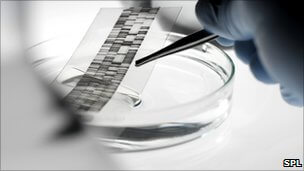DNA Genealogy

A lot has been said and claimed for DNA genealogy. The media is full of stories about DNA test results being used to solve crimes, prove/disprove paternity suits and prove or disprove family connections. We have all heard the stories about prisoners being released from jail after being vindicated by DNA testing and about others who were captured and prosecuted by DNA evidence. Thomas Jefferson's African-American family and Charles Lindberg's German family are two examples of DNA testing being used to prove family connections. This is all well and good, but how does this apply to you and your genealogical research? The truth is that DNA genealogy can be a very useful tool in your genealogy bag of tricks but, it must be understood and used judiciously. Otherwise you could end up spending a lot of time and money on information that is of little or no value to your genealogy project.
How does this stuff work?
DNA or more completely deoxyribonucleic acid is a set of instructions on how to construct a human. The instructions include a set of biological algorithms or programs that instruct the body on how to perform its basic functions, akin to a computer operating system whose patches or fixes were donated by your ancestors over millions of years, rather than by Microsoft. (Patches and fixes to our DNA from Microsoft would have been disastrous for humans, sorry, I couldn't resist). While in theory, your DNA contains your entire family history, we do not yet have a sure way of getting at it. In addition, what we can get out falls into the realm of probability and is therefore not 100% precise.
So what is this stuff good for?
DNA testing can provide some useful information and if used correctly can be an excellent adjunct to a well planned family history search. You can expect to obtain the following information:
1. Clues to your ethnic origin.
2. Find out if you are related to another individual.
3. Find out if two individuals descend from the same maternal or paternal ancestor.
4. Find out if you are related to others with your same surname.
5. Prove or disprove questions about your family history research.
6. Help in putting together a genealogical family tree online.
Cord blood stem cells are used as medical treatment that can be stored away for future use. By extracting blood stem cells from the umbilical cord, research has shown that this cell can differentiate with other cell tissues. This process giving the possibility to treat certain diseases. CryoBank - One of the nation's most experienced and respected cord blood banks, with 15 years of cord blood storage experience can help you with the process and other information.
Okay, So what do I have to know
In order to conduct a reasonably accurate and useful DNA search, you don't have to become an expert on DNA Genealogy, you just have to know a few things, including, what the various tests are, how they work and what they can tell you. Although, if you would like to further enhance your knowledge why not study or learn about what it takes to be a medical researcher.
Your DNA contains segments that are called chromosomes and these contain genes which are the basic building blocks of heredity. Each one of your parents contributed 23 chromosomes into the construction of you. One of these chromosomes, the 23rd one, determines your sex. Your mother contributed an X chromosome and your father either an X or a Y chromosome. If your father contributed an X, then you are female. If your father contributed a Y chromosome, then you are male. Henry the VIII never did figure out that it was his fault he wasn't getting any male heirs, not his wives. If he had only known, a few people might have been able to keep their heads.
Now, I'm not going to get too technical, but there are a couple more things that you need to know. We know that a portion of the Y-chromosome is passed down the male line, essentially unchanged. As a result, we can test to see if 2 males are related in the male line by having a common male ancestor (Most Recent Common Ancestor or MRCA). The test cannot tell us in which generation the two males have a common ancestor, though. We also know that there is another type of DNA called mitochondrialDNA or mtDNA that is passed from mothers to sons and daughters; it stops with the sons, but continues almost unchanged in the female line. So now we can tell if two females are related in the maternal line. A male can also identify his birth mother with this test in the case of an adoption. Remember that when testing females for a common female ancestor, we cannot tell in which generation they have a common ancestor or if they are closely related. We can only be fairly certain that there is a general relatedness between the two.
We also know that your DNA contains sequences that can be tracked to certain geographical areas and therefore provides clues to your ethnicity. We also know that many ethnic groups have certain DNA sequences in common (haplogroups), thus giving us a bit more certainty as to an individual's ethnicity(s). This type of test is called Single Nucleotide Polymorphisms (SNPs) (also ancestry by DNA or Ancestral History) and the results are expressed as a percentage.
Now that we have a fairly good idea of how this DNA testing stuff works. Let’s look at some real world testing examples, their limitations, applications and how to get the most out of your DNA genealogy study.
